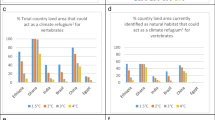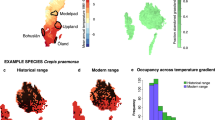Abstract
Climate change is one of the main factors that will affect biodiversity in the future and may even cause species extinctions. We suggest a methodology to derive a general relationship between biodiversity change and global warming. In conjunction with other pressure relationships, our relationship can help to assess the combined effect of different pressures to overall biodiversity change and indicate areas that are most at risk. We use a combination of an integrated environmental model (IMAGE) and climate envelope models for European plant species for several climate change scenarios to estimate changes in mean stable area of species and species turnover. We show that if global temperature increases, then both species turnover will increase, and mean stable area of species will decrease in all biomes. The most dramatic changes will occur in Northern Europe, where more than 35% of the species composition in 2100 will be new for that region, and in Southern Europe, where up to 25% of the species now present will have disappeared under the climatic circumstances forecasted for 2100. In Mediterranean scrubland and natural grassland/steppe systems, arctic and tundra systems species turnover is high, indicating major changes in species composition in these ecosystems. The mean stable area of species decreases mostly in Mediterranean scrubland, grassland/steppe systems and warm mixed forests.




Similar content being viewed by others
References
Alcamo J (ed) (1994) Image 2.0: integrated modelling of global climate change. Kluwer, Dordrecht
Alkemade R, van Oorschot M, Miles L, Nellemann C, Bakkenes M, ten Brink B (2009) GLOBIO3: a framework to investigate options for reducing global terrestrial biodiversity loss. Ecosystems 12(3):374–390. doi:10.1007/s10021-009-9229-5
Araujo MB, Rahbek C (2006) How does climate change affect biodiversity? Science 313(5792):1396–1397. doi:10.1126/science.1131758
Araujo MB, Thuiller W, Pearson RG (2006) Climate warming and the decline of amphibians and reptiles in Europe. J Biogeogr 33(10):1712–1728
Bakkenes M, Alkemade JRM, Ihle F, Leemans R, Latour JB (2002) Assessing effects of forecasted climate change on the diversity and distribution of European higher plants for 2050. Glob Chang Biol 8(4):390–407
Bakkenes M, Eickhout B, Alkemade R (2006) Impacts of different climate stabilisation scenarios on plant species in Europe. Glob Environ Change 16(1):19–28. doi:10.1016/j.gloenvcha.2005.11.001
Beaumont LJ, Hughes L (2002) Potential changes in the distributions of latitudinally restricted Australian butterfly species in response to climate change. Glob Chang Biol 8(10):954–971
Both C, Bouwhuis S, Lessells CM, Visser ME (2006) Climate change and population declines in a long-distance migratory bird. Nature 441(7089):81–83. doi:10.1038/nature04539
Bouwman A, Kram T, Klein Goldewijk K (eds) (2006) Integrated modelling of global environmental change. An overview of IMAGE 2.4. Netherlands Environmental Assessment Agency (MNP), Bilthoven
Broennimann O, Thuiller W, Hughes G, Midgley GF, Alkemade JMR, Guisan A (2006) Do geographic distribution, niche property and life form explain plants’ vulnerability to global change? Glob Chang Biol 12(6):1079–1093. doi:10.1111/j.1365-2486.2005.01157.x
EEA (2004) Impacts of Europe’s changing climate—an indicator-based assessment. EEA report, vol 2/2004. European Environment Agency, Copenhagen
EEA (2008) Impacts of Europe’s changing climate—2008 indicator-based assessment. EEA report, vol 4/2008. European Environment Agency, Copenhagen
Eickhout B, Den Elzen MGJ, Van Vuuren D (2003) Multi-gas emission profiles for stabilising greenhouse gas concentration. Emission implications of limiting global temperature increase to 2°C. RIVM report 728001026. National Institute of Public Health and the Environment, Bilthoven
Eickhout B, Den Elzen MGJ, Kreileman GJJ (2004) The atmosphere-ocean system of IMAGE 2.2. A global model approach for atmospheric concentrations, and climate and sea-level projections. RIVM report 481508017. National Institute of Public Health and the Environment, Bilthoven
Erasmus BFN, Van Jaarsveld AS, Chown SL, Kshatriya M, Wessels KJ (2002) Vulnerability of South African animal taxa to climate change. Glob Chang Biol 8(7):679–693
Ezcurra E (2006) Global deserts outlook. UNEP/DEWA, Nairobi
Gregory RD, Willis SG, Jiguet F, Voříšek P, Klvanova A, van Strien A, Huntley B, Collingham YC, Couvet D, Green RE (2009) An Indicator of the impact of climatic change on European bird populations. PLoS ONE 4(3):e4678
Hijmans RJ, Graham CH (2006) The ability of climate envelope models to predict the effect of climate change on species distributions. Glob Chang Biol 12(12):2272–2281
Huntley B, Berry PM, Cramer W, McDonald AP (1995) Modelling present and potential future ranges of some European higher plants using climate response surfaces. J Biogeogr 22(6):967–1001
IPCC, Ed., 2001: Climate change 2001: the scientific basis. Contribution of Working Group I to the Third Assessment Report of the Intergovernmental Panel on Climate Change (IPCC), Cambridge University Press, Cambridge, UK and New York, NY, USA
Jalas J, Suominen J (1989) Atlas florae Europaeae: distribution of vascular plants in Europe, vols 1–10. The Committee for Mapping the Flora of Europe and Societas Biologica Fennica Vanamo, Helsinki
Jetz W, Wilcove DS, Dobson AP (2007) Projected impacts of climate and land-use change on the global diversity of birds. PLoS Biol 5(6):1211–1219
Leemans R, Eickhout B (2004) Another reason for concern: regional and global impacts on ecosystems for different levels of climate change. Glob Environ Change 14(3):219–228
Loebl M, van Beusekom JEE, Reise K (2006) Is spread of the neophyte Spartina anglica recently enhanced by increasing temperatures? Aquat Ecol 40(3):315–324. doi:10.1007/s10452-006-9029-3
Midgley GF, Hannah L, Millar D, Rutherford MC, Powrie LW (2002) Assessing the vulnerability of species richness to anthropogenic climate change in a biodiversity hotspot. Glob Ecol Biogeogr 11(6):445–451
Millennium Ecosystem Assessment (2005) Ecosystems and human well-being: synthesis. Island Press, Washington, DC
Mitchell JFB, Johns TC, Gregory JM, Tett SFB (1995) Climate response to increasing levels of greenhouse gases and sulfate aerosols. Nature 376(6540):501–504
Nakicenovic N, Swart R (eds) (2000) Emissions scenarios. 2000 special report of the Intergovernmental Panel on Climate Change. Cambridge University Press, Cambridge
Nellemann C (2004) The fall of the water. UNEP-GRID, Arendal
Ohlemüller R, Gritti ES, Sykes MT, Thomas CD (2006) Towards European climate risk surfaces: the extent and distribution of analogous and non-analogous climates 1931–2100. Glob Ecol Biogeogr 15(4):395–405
Parmesan C (2006) Ecological and evolutionary responses to recent climate change. Annu Rev Ecol Evol Syst 37:637–669. doi:10.1146/annurev.ecolsys.37.091305.110100
Parmesan C, Yohe G (2003) A globally coherent fingerprint of climate change impacts across natural systems. Nature 421(6918):37–42
Parmesan C, Ryrholm N, Stefanescu C, Hill JK, Thomas CD, Descimon H, Huntley B, Kaila L, Kullberg J, Tammaru T, Tennent WJ, Thomas JA, Warren M (1999) Poleward shifts in geographical ranges of butterfly species associated with regional warming. Nature 399(6736):579–583
Peterson AT, Sanchez-Cordero V, Soberon J, Bartley J, Buddemeier RW, Navarro-Siguenza AG (2001) Effects of global climate change on geographic distributions of Mexican Cracidae. Ecol Modell 144(1):21–30
Peterson AT, Ortega-Huerta MA, Bartley J, Sanchez-Cordero V, Soberon J, Buddemeier RH, Stockwell DRB (2002) Future projections for Mexican faunas under global climate change scenarios. Nature 416(6881):626–629
Petit S, Firbank R, Wyatt B, Howard D (2001) MIRABEL: models for integrated review and assessment of biodiversity in European landscapes. Ambio 30(2):81–88
Potting J, Bakkes J (eds) (2004) The GEO-3 scenarios 2002–2032 quantification and analysis of environmental impacts, vol UNEP/DEWA/RS.03-4 RIVM 402001022. Report UNEP/DEWA. UNEP/RIVM, Nairobi
Root TL, Price JT, Hall KR, Schneider SH, Rosenzweig C, Pounds JA (2003) Fingerprints of global warming on wild animals and plants. Nature 421(6918):57–60
Sala OE, Chapin FS III, Armesto JJ, Berlow E, Bloomfield J, Dirzo R, Huber-Sanwald E, Huenneke LF, Jackson RB, Kinzig A, Leemans R, Lodge DM, Mooney HA, Oesterheld M, Poff NL, Sykes MT, Walker BH, Walker M, Wall DH (2000) Global biodiversity scenarios for the year 2100. Science 287(5459):1770–1774
Scholes RJ, Biggs R (2005) A biodiversity intactness index. Nature 434(7029):45–49
Smith JB, Schneider SH, Oppenheimer M, Yohe GW, Hare W, Mastrandrea MD, Patwardhan A, Burton I, Corfee-Morlot J, Magadza CHD, Füssel H-M, Pittock AB, Rahman A, Suarez A, van Ypersele J-P (2009) Assessing dangerous climate change through an update of the Intergovernmental Panel on Climate Change (IPCC) “reasons for concern”. Proc Natl Acad Sci USA 106:4133–4137
Sykes MT, Prentice IC, Cramer W (1996) A bioclimatic model for the potential distributions of north European tree species under present and future climates. J Biogeogr 23(2):203–233
Thomas CD, Lennon JJ (1999) Birds extend their ranges northwards. Nature 399(6733):213
Thomas CD, Cameron A, Green RE, Bakkenes M, Beaumont LJ, Collingham YC, Erasmus BFN, de Siqueira MF, Grainger A, Hannah L, Hughes L, Huntley B, van Jaarsveld AS, Midgley GF, Miles L, Ortega-Huerta MA, Peterson AT, Phillips OL, Williams SE (2004) Extinction risk from climate change. Nature 427(6970):145–148. doi:10.1038/Nature02121
Thuiller W (2003) BIOMOD—optimizing predictions of species distributions and projecting potential future shifts under global change. Glob Chang Biol 9(10):1353–1362
Thuiller W, Araujo MB, Pearson RG, Whittaker RJ, Brotons L, Lavorel S (2004) Biodiversity conservation—uncertainty in predictions of extinction risk. Nature 430(6995). doi:10.1038/Nature02716
Thuiller W, Broennimann O, Hughes G, Alkemade JRM, Midgley GF, Corsi F (2006) Vulnerability of African mammals to anthropogenic climate change under conservative land transformation assumptions. Glob Chang Biol 12(3):424–440. doi:10.1111/j.1365-2486.2006.01115.x
UNEP (2004) Strategic plan: future evaluation of progress. Convention on biological diversity VII/30. United Nations Environment Programme, Nairobi
UNEP (2007) Global environment outlook 4—environment for development. United Nations Environmental Programme, Nairobi
Van Herk CM, Aptroot A, Van Dobben HF (2002) Long-term monitoring in The Netherlands suggests that lichens respond to global warming. Lichenologist 34(2):141–154
Van Vuuren D, Den Elzen MGJ, Berk MM, Lucas P, Eickhout B, Eerens H, Oostenrijk R (2003) Regional costs and benefits of alternative post-Kyoto climate regimes. Comparisons of variants of the multi-stage and per capita convergence regimes. vol RIVM report 728001025. National Institute for Public Health and the Environment, Bilthoven
Walther GR, Post E, Convey P, Menzel A, Parmesan C, Beebee TJC, Fromentin JM, Hoegh-Guldberg O, Bairlein F (2002) Ecological responses to recent climate change. Nature 416(6879):389–395
Walther GR, Berger S, Sykes MT (2005) An ecological ‘footprint’ of climate change. Proc R Soc B Biol Sci 272(1571):1427–1432. doi:10.1098/rspb.2005.3119
Acknowledgments
This research is carried out as part of the GLOBIO consortium (http://www.globio.info). We thank Wolfgang Cramer (Potsdam) for valuable comments on earlier versions of the manuscript.
Author information
Authors and Affiliations
Corresponding author
Additional information
Bas Eickhout is a member of the European Parliament.
Rights and permissions
About this article
Cite this article
Alkemade, R., Bakkenes, M. & Eickhout, B. Towards a general relationship between climate change and biodiversity: an example for plant species in Europe. Reg Environ Change 11 (Suppl 1), 143–150 (2011). https://doi.org/10.1007/s10113-010-0161-1
Received:
Accepted:
Published:
Issue Date:
DOI: https://doi.org/10.1007/s10113-010-0161-1




